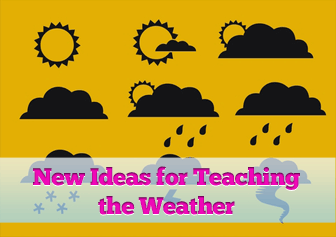New Ideas for Teaching the Weather


That general interest is just one of the reasons your ESL class will enjoy these activities planned around extreme weather, so take shelter and jump right in!

A Plan for Disaster
From the time that we were young, we heard our teachers, firefighters and police officers talk about having a family disaster plan. The intent of these plans is to prepare in case of an emergency, to make sure your family knows how to stay safe and find each other in an emergency. Challenge your students to develop their own family disaster plan in case of extreme weather or another disaster at home. Your students can follow these step-by-step instructions to develop emergency plans and get reading comprehension practice at the same time, but your students will have to do a little research, too, to complete their family disaster plans. Either in groups or individually, students should make a list of the possible emergency situations that could happen in your community. After making the list, have pairs of students research how to handle each of these specific emergencies before writing their plans. Finally, have each student write out his family plan with the help of his parents and siblings. Not only will your class get language experience from the activity, they will be prepared in the rare case of a dangerous event!
A Twister is Coming
Tornadoes have been the subject of many movies, but two stand out as most popular. The first is The Wizard of Oz in which a tornado whisks Dorothy to the fanciful world of Oz, house and all, up in a funnel of wind. The second movie, which is centered around tornadoes, is Twister. In this popular film, storm chasers run after dangerous storms for weather research purposes. These two movies can provide your students with an opportunity to practice their observational as well as analytical skills. Start this activity by explaining to your class the function of a Venn diagram. These two overlapping circles are used to organize information about two different but similar items. Show your class clips from each movie. If you do not have your own copies you can use Wizard of Oz Tornado Scene and Twister the First Tornado Scene both available on YouTube.com. After viewing the two scenes, have your students work in pairs to complete the diagram. In the overlapping section of the diagram, they should write words which describe how the tornadoes were portrayed in both of the films. In the remaining space, they should give details about the tornadoes specific to each movie. They can then use that information to write a reaction to the movies.
If you have time to watch the entirety of Twister, you can introduce your students to the idea of storm chasers. These scientists research extreme weather through means similar to those portrayed in the movie. You can give your students additional exposure to storm chasers through episodes of Storm Chasers available on Discovery.com. Students can use the information they receive from these programs to decide which movie more accurately portrayed the tornadoes. You may also want to give your students some information on “tornado alley.” This area of the United States is most known for its frequency of tornadoes though the name is not official.
I Feel the Earth Shake
Depending on the area in which you live, earthquakes may be a realistic danger for your students. This instructional video on earthquake safety is not only informative, it makes a good cloze listening activity for your ESL students. Give your students a copy of the following steps to take in case of an earthquake (with the bold words removed). Then play the video for them several times challenging them to fill in the blanks. Once your students have finished watching the video, have pairs compare their answers, and then give the correct answers to your class. You may choose to review unfamiliar vocabulary after you have given your students the correct answers.
The Ring of Fire
Are you and your students familiar with the expression “The Ring of Fire”? The Pacific Ring of Fire is an expression used to describe the area of the Pacific which is home to over 75% of the world’s volcanoes! Though your students will probably never experience a volcanic eruption first hand, they can get some map reading skills by plotting the earth’s active volcanoes on a world map. Using this list, have your students work in small groups or as a class to mark the location of these volcanoes. Which area of the world has the most volcanoes? Now give your students some basic information on the Pacific Ring of Fire. You can use this short article from Wikipedia, before asking each person to explain in his own words, either written or as an oral interview, why he thinks the Ring of Fire is a good or bad name for that area of the world.
Help to the Rescue
When communities suffer natural disasters, emergency relief agencies often step in to help. Some of the most popular relief agencies are the International Red Cross, Doctors Without Borders, and Mercy Corps. Set groups of students to some online research to investigate the history of one of these agencies. They should be able to find source material quickly and easily. You may want to give your students a list of questions to get them started on their research. What services does the agency provide today? How does the agency determine which communities need assistance? When and why was the organization founded? Where do they get the money to support their services? Once your students have completed their research, make time for group presentations. Ask your students to collectively present the information they found, and make sure each student plays some part in the presentation. Not only will these presentations give your students speaking practice, they will also provide information about emergency services that could be useful at some point in the future.
They will improve their language skills in the process and gain some of the knowledge necessary to keep safe in an emergency.